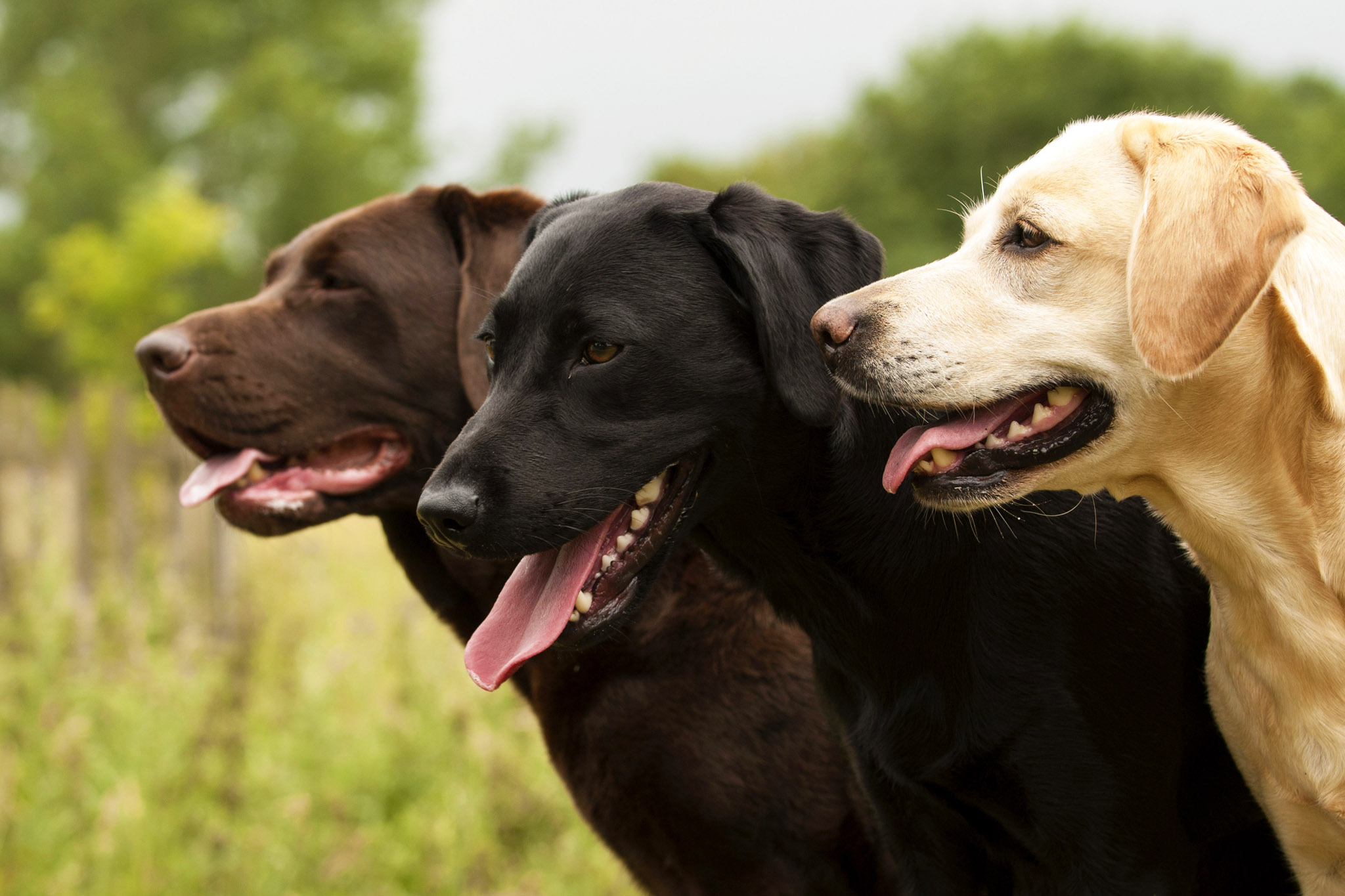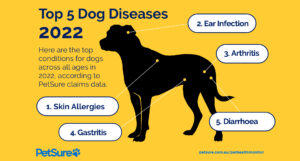Labrador | Traits | training | Typical health problems
This section outlines Labradors traits, training and typical health problems.
Labrador | Breed highlights
| Breed: | Labrador Retrievers (Labradors or Labs) are medium to large dogs with a friendly disposition, intelligence, and an agile physique. |
| Coat type: | Labradors are short-haired. The breed has a double coat, an undercoat that is softer and water resistant, and a top coat of denser fur. |
| Shedding: | Labradors are moderately shedding dogs and need weekly brushing. However, the breed undergoes a heavier moult twice a year, requiring more grooming. |
| Grooming: | Bathe Labradors only when required (or once a month at most). A regular grooming routine should include nail clipping and teeth brushing. |
| Activity level: | High. Labradors need regular daily exercise to keep physically fit. |
| Apartment friendly: | As large dogs, Labradors need space. Therefore, homes with a backyard are best for this breed. |
| Small children: | Labradors are sweet-natured and get along well with children. Supervision is always advised. |
| Other dog friendly: | Yes. Labradors are a social dog breed. |
What type of breed is a Labrador?
Labrador Retrievers are famous for their gentle and affectionate temperaments. They are intelligent, highly trainable and have an innate desire to please. Labs are classified as sporting dogs and the breed ranks among Australia’s most popular.
History of Labradors
Labradors have a history extending as far back as the 1700s. Bred initially in the Canadian province of Newfoundland, Labradors became notable for their skills as fishing dogs. The breed rose to prominence as it could fetch on demand and their water-resistant coats allowed them to swim in chilly waters. The breed’s lineage remains a keen swimmer and highly responsive to training. Labradors frequently work as service dogs, helping people with disabilities, or are employed as border control animals.
Labrador appearance and characteristics
Labradors have solid bodies and with proper exercise, should appear muscular. However, the breed tends to become overweight due to a voracious appetite, so daily physical activity is a must, as is a moderate diet. Labradors are between 55 and 62 centimetres tall and weigh 25 – 36 kilograms. Females are a bit smaller. Labs come in three colours: black, yellow, and chocolate.
Labrador personality and temperament
Labs are friendly, sweet-natured and naturally docile. In addition, they are intelligent and respond to training. This combination makes them ideal family pets or for people who are first-time dog owners.
The breed is social and gets on well with other animals. Thanks to an agreeable temperament, Labs fit into homes with young children. They are loyal and loving companions and quite dedicated to the happiness of their owners.
Labrador traits
Labradors are highly energetic and need lots of exercise. Walking and running are excellent, as is swimming. Additional activities such as a game of fetch, helps keep their minds active.
Despite their docile nature, a trait which Labradors are famous for, as puppies are excitable. Labrador puppies tend to become more mature around 18 months; and puppy preschool will help channel an enthusiastic pup’s energy. The added benefit is that training helps identify and correct undesirable attributes in a safe and social setting.
Labrador Lifespan
On average, the lifespan of a Labrador is between 12-14 years.
The dos and don’ts of caring for a Labrador
Do: Always pay special attention to your Labrador’s diet. Ensuring your Lab doesn’t become overweight can help with the onset of health conditions like arthritis.
Don’t: Over bathe. Labradors only require a bath when they are dirty or if they smell. Bathe once a month at most. More often than this, there is the risk of stripping the fur of its natural oil.
Do: Learn how to brush your Labrador’s teeth. Tooth brushing for this food-focused breed keeps the teeth free of plaque and the gums healthy. You may want to watch Petsure’s Masterclass for top tips for brushing your dog’s teeth.
Common conditions for Labrador
| Conditions | Symptoms can include~ | Highest cost for a single treatment* |
| Gastrointestinal (tummy) problems | · Diarrhoea, vomiting or constipation. · Blood or mucous in stool/vomit. · Increased frequency/urgency passing stool. · Weight loss. · Loss of appetite and interest in food. · May seem more tired than usual. | $15,602 |
| Ingestion of foreign item or toxin. | · Vomiting, diarrhoea, loss of appetite. · Abdominal pain, frequent stretching, vocalising or sensitivity to touch. · Lethargy. · Drooling. | $17,101 |
| Ear Conditions -including infections and allergies | · Scratching, rubbing, or pawing at one of both ears. · Head shaking · Odour or discharge from the ears · Ears may be red or warm to the touch | $4378 |
| Skin Conditions, including – infections and allergies | · Scratching, biting, or rubbing the skin. · Signs of irritation, including red skin, scabs, bleeding, pustules, or weeping. · Hair loss, flaky skin, texture changes, lumps or an unusual or unpleasant smell. | $7,752 |
| Arthritis | · Limping on an affected limb/s · Stiffness on rising · Reluctance to jump or head up and down stairs · Swelling on pet’s legs | $4,096 |
Disclaimer: Reimbursement for these claims would be subject to limits, such as annual benefit limits or sub-limits, benefit percentage, applicable waiting periods and any applicable excess. Cover is subject to the policy terms and conditions. You should consider the relevant Product Disclosure Statement or policy wording available from the relevant provider.
* Please note that the values calculated are based on all claims for that condition and medically related conditions in each calendar year.
Types of pet insurance from PetSure
| Policy type | Policy description |
| Accidents | This product provides cover for specified accidental injuries up to an annual policy limit. Most policies will reimburse a stated Benefit Percentage that is typically 80% of eligible vet bills. Some condition sub-limits may also apply, with all annual limits resetting each year when the policy is renewed. It’s important to know that only defined accidents as listed in the policy’s Product Disclosure Statement will be covered (other conditions will not be covered). More information on what is typically covered and not covered in our find a policy page. |
| Basic care | This product provides limited cover for both specified accidental injuries and illness conditions, with a stated Benefit Percentage that can range from 60-90%. Treatments and medications for eligible conditions are typically covered subject to the applicable policy limits. Claimable conditions have an annual condition limit , meaning once the condition limit (subject to the annual benefit limit) has been reached in an annual policy period, costs relating to that condition will need to be covered entirely by the policyholder. However, annual benefit limits and applicable annual condition limits reset on renewal each year. More information on what is typically covered and not covered in our find a policy page. |
| Comprehensive / Accident and Illness | This product provides comprehensive cover for both specified accidental injuries and illness conditions, with a stated Benefit Percentage that will typically range from 70-85%. You can claim up to an annual maximum limit each year, which resets on renewal. Sub-limits for certain items may also apply. More information on what is typically covered and not covered in our find a policy page. |
Insurance products are issued by The Hollard Insurance Company Pty Ltd ABN 78 090 584 473, AFSL 241436 (Hollard) and/or PetSure (Australia) Pty Ltd ABN 95 075 949 923, AFSL 420183 (PetSure) (from 8 May 2023 only), administered by PetSure and promoted and distributed through their authorised representatives and distribution partners.
Any advice provided is general only and does not take into account your individual objectives, financial situation or needs. Cover is subject to the policy terms and conditions. Please consider the Product Disclosure Statement (PDS) to ensure this product meets your needs before purchasing, or choosing to continue with the product. PDS and Target Market Determination available on our partners’ websites. Meet our partners at petsure.com.au/partners.
Pet insurance can help by covering a portion of the eligible vet bill if the unexpected happens. Because it is difficult to predict the costs of veterinary care, it can help to have measures in place to help prepare for the unexpected. Check out our partner network and explore our policy tools to find a pet insurance policy.
Not all conditions or items are covered by Pet Insurance. Refer to the applicable Product Disclosure Statement for information about coverage and exclusions.
Frequently Asked Questions
While generally considered healthy, the breed can be prone to the following conditions:
· Hip dysplasia
· Elbow dysplasia
· Canine Arthritis
Labradors come in three colours: yellow, chocolate, and black. Some claim there are differences between the three colours regarding personality: yellow Labs are the most relaxed, chocolate Labs are more rowdy and black Labs make the best hunters. However, no formal research backing these claims exists.
Labradors are popular and continue to make the top ten lists in Australia. The breed is friendly, adaptable and fits in well with families. However, potential Labrador owners must commit to regular exercise, a well-managed diet, and the ability to say no to any extra treats.
The most popular names for a Labrador are?
1. Luna
2. Daisy
3. Charlie
4. Coco
5. Max
6. Archie
7. Molly
8. Milo
9. Bonnie
10. Willow
References
https://www.australiandoglover.com/2015/09/labrador-retriever.html
https://www.purina.com.au/dogs/breeds/labrador-retriever
https://www.hillspet.com.au/dog-care/dog-breeds/labrador-retriever
https://www.britannica.com/animal/Labrador-retriever
The author of this article has been updated. Dr Claire Sharp was attributed as the author, and we unreservedly apologise to her and to the author for crediting her as the author of the article.
Pet insurance can help by covering a portion of the eligible vet bill if the unexpected happens. Because it is difficult to predict the costs of veterinary care, it can help to have measures in place to help prepare for the unexpected. Check out our partner network and explore our policy tools to find a pet insurance policy.
Not all conditions or items are covered by Pet Insurance. Refer to the applicable Product Disclosure Statement for information about coverage and exclusions.



 Fact checked
Fact checked





